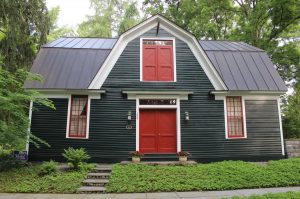
199 Woodlawn Avenue – 1897 Private Stable of 632 North Broadway, now the private residence of James and Cheryl Gold.
With little to no fanfare or discussion at a recent City Council meeting, two historic properties, 199 and 200 Woodlawn Avenue, were added to the City of Saratoga Springs’ Local Historic District. In 2009, owners James and Cheryl Gold and Wayne and Trudi Smith were active supporters of Saratoga Springs Preservation Foundation’s efforts to expand the Local Historic District to match the boundaries of the Broadway Historic District listed on the National Register of Historic Places when 23 Greenfield Avenue was proposed to be demolished.
As neighbors of the handsome pre-Civil War Italianate house that was listed as a contributing building to the Broadway Historic District listed on the National Register of Historic Place, they felt that the demolition would be a significant loss to the neighborhood and potentially have a negative impact on the value of their properties.
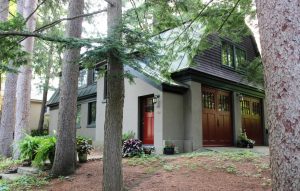
200 Woodlawn Avenue – 1911 Garage of 655 North Broadway, now the private residence of Wayne and Trudi Smith. The house was referred to as “Tree-Tops” in the deed, perhaps a reference to the many spruce and hemlock trees.
For those who are not aware, being listed on the National Register of Historic Places is primarily an honorary designation, only providing a measure of protection if state or federal funds are involved with a project. Designation on the National Register does not place any restrictions on exterior changes nor does it provide protection against demolition. However, buildings located within the City of Saratoga Springs’ Local Historic District require review of exterior changes, new construction, and demolition by the mayor-appointed Design Review Commission.
Unfortunately, there was insufficient neighborhood support to expand the Local Historic District to match the boundaries of Broadway Historic District listed on the National Register and ultimately 23 Greenfield Avenue was lost. Since that time the Golds and the Smiths have seen several houses within their neighborhood be demolished and replaced with larger homes. While some of the houses were not historic and did not contribute to the historic district, others did – 49 State Street, 89 State Street, and 1 First Street.
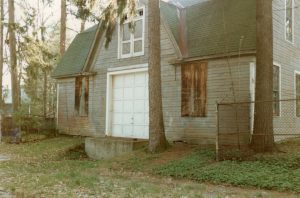
199 Woodlawn Avenue as it looked when it was purchased by the Gold’s in 1987.
“My wife and I saw potential of the dilapidated stable at 199 Woodlawn Avenue and invested significant time and money to convert the structure into our home,” stated Jim Gold, owner of 199 Woodlawn Avenue. “We want to protect not only the investment that we made in the property, but also protect and preserve the historic integrity of the neighborhood,” he continued.
The stable that is now their residence was constructed in 1897 for Sidney and Minerva Rickard, residents of 632 North Broadway. Sidney Rickard was a founding partner and officer of G.F. Harvey Company, which patented the process for converting medicine powders into pills, and Minerva was one of the founders Saratoga Hospital. Sidney passed away in 1902 and Minerva maintained ownership until 1910 when she conveyed it to real estate broker Amos F. Eno. Eno lived on Fifth Avenue in New York City and summered at 677 North Broadway. Following his death, 677 North Broadway and 199 Woodlawn Avenue were left to Columbia University. The Trustees of Columbia University conveyed the stable at 199 Woodlawn to Anna F. Somers, who lived at 659 North Broadway, in 1928.
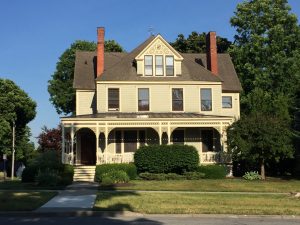
632 North Broadway, the 1884 Queen Anne where Sidney and Minevra Rickard lived when they built the stable at 199 Woodlawn Avenue.
A year later the stable was conveyed to J. Marvin Gage, the younger son of William B. Gage, the proprietor of the United States Hotel who lived at 779 North Broadway. J. Marvin Gage never married and maintained a seven room apartment at 504½ Broadway, The Algonquin, until his death in 1954. The stable was listed in the City Directories as vacant between 1930 and 1933. The following year it was listed as Gage’s “private stable.” Following his death, the contents of his estate were sold at two public auctions. The first auction took place at his apartment and the second took place at 199 Woodlawn Avenue and included a 1925 Dodge Roadster and a 1937 Studebaker that “look like new.”
In 1957, the heirs conveyed the property to G.F. Blackmer & Sons, Inc., an office equipment, furniture, janitorial supplies and wholesale paper product and office supply company located at 28-32 Clinton Street that used the building for storage for 25 years. In 1982, the property was sold to two sisters who were unsuccessful in getting the proper approvals to convert it into two apartments.
In 1987 Jim and Cheryl Gold purchased the vacant stable to convert it into their residence. With both of their backgrounds in historic preservation, they took great care in preserving many of the original details of the building – clapboard siding, 16/16 windows, and the hayloft doors – and designing carriage doors using the hayloft doors as a guide.
Across the street is a similar story, Wayne and Trudi Smith, artists who had restored a Brooklyn brownstone over a period of 17 years, purchased 200 Woodlawn Avenue initially as a weekend retreat in 1995. The widow of W. Stone Smith, a principal of a stove manufacturing company, Dorothy Stone-Smith and her daughter Alice Smith built the stucco Craftsman style structure at the rear of their property at 655 North Broadway to serve as a garage and a housekeeper’s apartment in 1911. In 1921, the property was conveyed to the owner and publisher of “The Saratogian” John K. Waldbridge and his wife Marion. In 1954, Marion subdivided the property and sold the garage to her housekeeper, Margaret C. Jones, who occupied it with her spouse, Frank, and her five children.
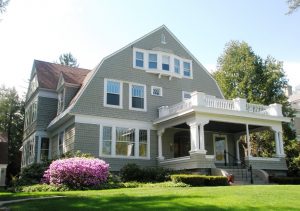
655 Broadway, the 1897 Shingle Style house associated with 200 Woodlawn Avenue.
The property remained in the Jones family until 1978 when they sold it to artist Penelope Benson-Wright, who lived and had pottery studio there. In 1995, the Smiths purchased the property. Not very long after, they found themselves wanting to live full-time in Saratoga Springs. However, they soon realized in order to make room for their antique collection that they would need more space than the apartment above the garage provided. The Smiths converted to the garage space into a living room, dining room, and kitchen. The Smiths retained many of the original features including the pressed metal ceilings, woodwork, the 19 wood casement windows, and garage doors.
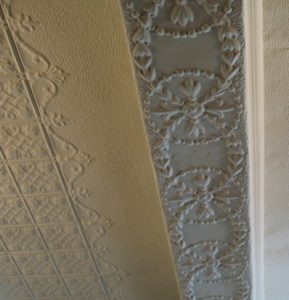
The pressed metal ceiling that the Smiths preserved. Coincidentally, the Golds had the same metal ceiling and were able to provide the Smiths with panels to replace the ones that are missing.
“Saratoga Springs has a beautiful variety of historic architecture that has been maintained, preserved, and adapted for contemporary use by its residents. We hope that by including our home in the local historic district we can help preserve what makes Saratoga Springs so unique and special,” commented Wayne Smith. “The Foundation appreciates the effort and investment that the Golds and the Smiths have made to preserve these wonderful buildings that help tell the story of Saratoga Springs. We hope other historic building owners will see the benefits of being in the local district and want to voluntarily add their property,” Linda Harvey-Opiteck, President of the Saratoga Springs Preservation Foundation.
For those who are interested in having the investment in their historic property preserved and protected for future generations, please contact the Foundation at (518) 587-5030 and/or the Bradley Birge, Administrator of the Planning and Economic Development of the City of Saratoga Springs at (518) 587-3550.
